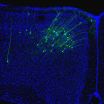(Press-News.org) If ever there were a silver lining to global warming, it might be the prospect of milder winters. After all, it stands to reason that a warmer climate would generate less snow.
But a new MIT study suggests that you shouldn't put your shovels away just yet. While most areas in the Northern Hemisphere will likely experience less snowfall throughout a season, the study concludes that extreme snow events will still occur, even in a future with significant warming. That means that, for example, places like Boston may see less snowy winters overall, punctuated in some years by blizzards that drop a foot or two of snow.
"Many studies have looked at average snowfall over a season in climate models, but there's less known about these very heavy snowfalls," says study author Paul O'Gorman, an associate professor in MIT's Department of Earth, Atmospheric and Planetary Sciences. "In some regions, it is possible for average snowfall to decrease, but the snowfall extremes actually intensify."
O'Gorman studied daily snowfall across the Northern Hemisphere using 20 different climate models, each of which projected climate change over a 100-year period, given certain levels of greenhouse gas emissions. He looked at both average seasonal snowfall and extreme snowfall events under current climate conditions, and also following projected future warming.
Not surprisingly, O'Gorman found that under relatively high warming scenarios, low-elevation regions with winter temperatures initially just below freezing experienced about a 65 percent reduction in average winter snowfall. However, in these same regions, the heaviest snowstorms became only 8 percent less intense. In some higher-latitude regions, extreme snow events became more intense, depositing 10 percent more snow, even under scenarios of relatively high global warming.
"You might expect with a warmer climate there should be major changes in snowfall in general," O'Gorman says. "But that seems to be true to a greater extent for average snowfall than for the intensities of the heaviest snowfall events."
O'Gorman has published the results of his study this week in the journal Nature.
Daily snowfall
For the most part, researchers have only been able to analyze snowfall on a seasonal scale, estimating a winter's average snow amounts with climate change. Such analyses, while useful, only paint a broad picture of snowfall's response to global warming, and may miss specific events, like a large blizzard that may occur over a day or two.
Daily snowfall in a range of climate model simulations has recently been made available through the Coupled Model Intercomparison Project — a growing archive of climate modeling output, including snowfall, that modeling centers and researchers around the world contribute to and analyze.
O'Gorman analyzed daily snow amounts from simulations with 20 different climate models in the archive. Each model simulated a "control climate," for the years 1981 to 2000, as well as a "warm climate," for the years 2081 to 2100, assuming relatively high emissions of greenhouse gases.
Over this 100-year period, O'Gorman found that average snowfall decreased substantially in many Northern Hemisphere regions in warm-climate scenarios compared with the milder control climates, but that snowfall amounts in the largest snowstorms did not decrease to the same extent.
He warned, however, that changes in snowfall extremes can be larger in regions with little snowfall to begin with, such as the southwestern United States. He also notes that while this study focuses on percentage changes in the amount of snowfall in extreme snowfall events, there can be larger changes in the frequency of such events.
From the simulations, O'Gorman found that it takes greater climate warming to reduce the intensity of extreme snowstorms than to reduce average seasonal snowfall. Specifically, a region would experience less seasonal snow if average winter temperatures were initially above minus 14 degrees Celsius (7 degrees Fahrenheit). But the heaviest snowstorms would become less intense only above minus 9 C (16 F).
A sweet spot for extreme snowfall
What's more, O'Gorman found that there's a narrow daily temperature range, just below the freezing point, in which extreme snow events tend to occur — a sweet spot that does not change with global warming. This is in contrast to average snow events, which may occur over a broader temperature range.
"People may know the expression, 'It's too cold to snow' — if it's very cold, there is too little water vapor in the air to support a very heavy snowfall, and if it's too warm, most of the precipitation will fall as rain," O'Gorman says. "Snowfall extremes still occur in the same narrow temperature range with climate change, and so they respond differently to climate change compared to rainfall extremes or average snowfall."
INFORMATION:
Written by Jennifer Chu, MIT News Office
Snowfall in a warmer world
Study finds big snowstorms will still occur in the Northern Hemisphere following global warming
2014-08-27
ELSE PRESS RELEASES FROM THIS DATE:
Researchers change the emotional association of memories
2014-08-27
By manipulating neural circuits in the brain of mice, scientists have altered the emotional associations of specific memories. The research, led by Howard Hughes Medical Institute investigator Susumu Tonegawa at the Massachusetts Institute of Technology (MIT), reveals that the connections between the part of the brain that stores contextual information about an experience and the part of the brain that stores the emotional memory of that experience are malleable.
Altering those connections can transform a negative memory into a positive one, Tonegawa and his MIT colleagues ...
Witnessing the early growth of a giant
2014-08-27
Elliptical galaxies are large, gas-poor gatherings of older stars and are one of the main types of galaxy along with their spiral and lenticular relatives. Galaxy formation theories suggest that giant elliptical galaxies form from the inside out, with a large core marking the very first stages of formation.
However, evidence of this early construction phase has eluded astronomers — until now.
Astronomers have now spotted a compact galactic core known as GOODS-N-774, and nicknamed Sparky [1]. It is seen as it appeared eleven billion years ago, just three billion years ...
Stop and listen: Study shows how movement affects hearing
2014-08-27
DURHAM, N.C. -- When we want to listen carefully to someone, the first thing we do is stop talking. The second thing we do is stop moving altogether. This strategy helps us hear better by preventing unwanted sounds generated by our own movements.
This interplay between movement and hearing also has a counterpart deep in the brain. Indeed, indirect evidence has long suggested that the brain's motor cortex, which controls movement, somehow influences the auditory cortex, which gives rise to our conscious perception of sound.
A new Duke study, appearing online August 27 ...
NASA sees massive Marie close enough to affect southern California coast
2014-08-27
Two NASA satellites captured visible and infrared pictures that show the massive size of Hurricane Marie. Marie is so large that it is bringing rough surf to the southern coast of California while almost nine hundred miles west of Baja California.
On August 26 at 19:05 UTC (3:05 p.m. EDT) NASA's Terra satellite captured a visible image of Hurricane Marie drawing in the small remnants of Karina. Marie is over 400 miles in diameter, about the distance from Washington, D.C. to Boston, Massachusetts. Hurricane force winds extend outward up to 60 miles (95 km) from the center ...
Scripps Research Institute scientists link alcohol-dependence gene to neurotransmitter
2014-08-27
LA JOLLA, CA – August 27, 2014 – Scientists at The Scripps Research Institute (TSRI) have solved the mystery of why a specific signaling pathway can be associated with alcohol dependence.
This signaling pathway is regulated by a gene, called neurofibromatosis type 1 (Nf1), which TSRI scientists found is linked with excessive drinking in mice. The new research shows Nf1 regulates gamma-aminobutyric acid (GABA), a neurotransmitter that lowers anxiety and increases feelings of relaxation.
"This novel and seminal study provides insights into the cellular mechanisms of ...
Expression of privilege in vaccine refusal
2014-08-27
DENVER (August 27, 2014) – Not all students returning to school this month will be up to date on their vaccinations. A new study conducted by Jennifer Reich, a researcher at the University of Colorado Denver, shows that the reasons why children may not be fully vaccinated depends on the class privilege of their mothers.
According to the National Network for Immunization Information, three children per 1000 in the U.S. have never received any vaccines, with almost half of all children receiving vaccines later than recommended. The number of unvaccinated children has led ...
Dosage of HIV drug may be ineffective for half of African-Americans
2014-08-27
Many African-Americans may not be getting effective doses of the HIV drug maraviroc, a new study from Johns Hopkins suggests. The initial dosing studies, completed before the drug was licensed in 2007, included mostly European-Americans, who generally lack a protein that is key to removing maraviroc from the body. The current study shows that people with maximum levels of the protein — including nearly half of African-Americans — end up with less maraviroc in their bodies compared to those who lack the protein even when given the same dose. A simple genetic test for the ...
Scientists plug into a learning brain
2014-08-27
Learning is easier when it only requires nerve cells to rearrange existing patterns of activity than when the nerve cells have to generate new patterns, a study of monkeys has found. The scientists explored the brain's capacity to learn through recordings of electrical activity of brain cell networks. The study was partly funded by the National Institutes of Health.
"We looked into the brain and may have seen why it's so hard to think outside the box," said Aaron Batista, Ph.D., an assistant professor at the University of Pittsburgh and a senior author of the study published ...
Pitt and Carnegie Mellon engineers discover why learning can be difficult
2014-08-27
PITTSBURGH—Learning a new skill is easier when it is related to ability that we already possess. For example, a trained pianist might learn a new melody more easily than learning how to hit a tennis serve.
Neural engineers from the Center for the Neural Basis of Cognition (CNBC)—a joint program between the University of Pittsburgh and Carnegie Mellon University—have discovered a fundamental constraint in the brain that may explain why this happens. Published as the cover story in the Aug. 28, 2014, issue of Nature, they found for the first time that there are constraints ...
Kessler Foundation scientists study impact of cultural diversity in brain injury research
2014-08-27
West Orange, NJ. August 27, 2014. Kessler Foundation scientists examined the implications for cultural diversity and cultural competence in brain injury research and rehabilitation. The article by Anthony Lequerica, PhD, and Denise Krch, PhD: Issues of cultural diversity in acquired brain injury (ABI) rehabilitation (doi:10.3233/NRE-141079) was published by Neurorehabilitation. Drs. Lequerica and Krch are research scientists in Traumatic Brain Injury (TBI) Research at Kessler Foundation and co-investigators for the Northern New Jersey TBI Model System.
Cultural sensitivity ...
LAST 30 PRESS RELEASES:
Experiments advance potential of protein that makes hydrogen sulfide as a therapeutic target for Alzheimer’s disease
Examining private equity’s role in fertility care
Current Molecular Pharmacology achieves a landmark: real-time CiteScore advances to 7.2
Skeletal muscle epigenetic clocks developed using postmortem tissue from an Asian population
Estimating unemployment rates with social media data
Climate policies can backfire by eroding “green” values, study finds
Too much screen time too soon? A*STAR study links infant screen exposure to brain changes and teen anxiety
Global psychiatry mourns Professor Dan Stein, visionary who transformed mental health science across Africa and beyond
KIST develops eco-friendly palladium recovery technology to safeguard resource security
Statins significantly reduce mortality risk for adults with diabetes, regardless of cardiovascular risk
Brain immune cells may drive more damage in females than males with Alzheimer’s
Evidence-based recommendations empower clinicians to manage epilepsy in pregnancy
Fungus turns bark beetles’ defenses against them
There are new antivirals being tested for herpesviruses. Scientists now know how they work
CDI scientist, colleagues author review of global burden of fungus Candida auris
How does stroke influence speech comprehension?
B cells transiently unlock their plasticity, risking lymphoma development
Advanced AI dodel predicts spoken language outcomes in deaf children after cochlear implants
Multimodal imaging-based cerebral blood flow prediction model development in simulated microgravity
Accelerated streaming subgraph matching framework is faster, more robust, and scalable
Gestational diabetes rose every year in the US since 2016
OHSU researchers find breast cancer drug boosts leukemia treatment
Fear and medical misinformation regarding risk of progression or recurrence among patients with breast cancer
Glucagonlike peptide-1 receptor agonists and asthma risk in adolescents with obesity
Reviving dormant immunity: Millimeter waves reprogram the immunosuppressive microenvironment to potentiate immunotherapy without obvious side effects
Safety decision-making for autonomous vehicles integrating passenger physiological states by fNIRS
Fires could emit more air pollution than previously estimated
A new way to map how cells choose their fate
Numbers in our sights affect how we perceive space
SIMJ announces global collaborative book project in commemoration of its 75th anniversary
[Press-News.org] Snowfall in a warmer worldStudy finds big snowstorms will still occur in the Northern Hemisphere following global warming





